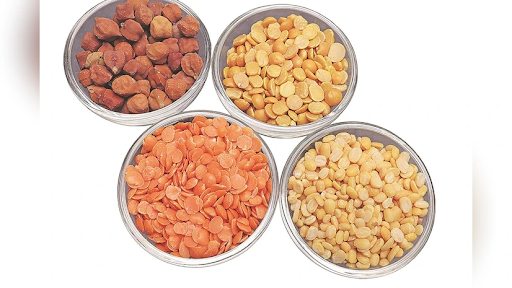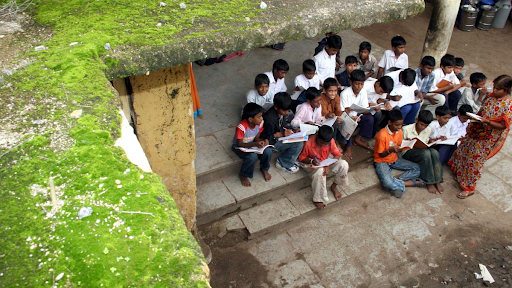Description

Copyright infringement not intended
Picture Courtesy: https://www.thehindu.com/sci-tech/energy-and-environment/digital-boost-to-revive-flailing-pm-kusum-programme/article68528979.ece
Context: The Global Energy Alliance for People and Planet has launched a digital platform in Rajasthan to map land parcels and track project progress under the PM-KUSUM scheme.
About PM-KUSUM Scheme
- The PM-KUSUM scheme was launched by the Ministry of New and Renewable Energy (MNRE) in February 2019.
- The Scheme has three components targeted to achieve solar power capacity addition of 30.8 GW by 31.3.2026.
Key Objectives of PM-KUSUM
- Installation of Solar Pumps: The scheme encourages the use of solar-powered water pumps for irrigation, reducing the dependency on conventional and often expensive electricity sources.
- Grid-Connected Solar and Renewable Energy Power Plants: It supports the establishment of solar and other renewable energy power plants connected to the grid, which can help to provide a steady supply of energy for agricultural use.
- Decentralization of Energy: By decentralizing energy sources, PM-KUSUM aims to make renewable energy more accessible to rural areas, enhancing sustainability and energy security.
- Solarization of Existing Pumps: The scheme also promotes the conversion of existing grid-connected agricultural pumps to solar-powered ones, which can lead to significant cost savings and environmental benefits.
Who Can Benefit?
The PM-KUSUM scheme is designed to be inclusive, covering a wide range of beneficiaries:
- Individual Farmers and Farmer Groups: This includes individual farmers, Self-Help Groups (SHGs), Joint Liability Groups (JLGs), and cooperatives of farmers.
- Panchayats: Local self-government bodies can also participate in the scheme.
- Farmer Producer Organizations (FPOs) and Water User Associations (WUAs): These organizations can implement renewable energy projects to benefit multiple farmers.
- Other Eligible Entities: This category includes entities permitted by the Ministry of New and Renewable Energy (MNRE), which may also involve local developers or DISCOMs (Distribution Companies) that act as Renewable Power Generators (RPGs).
PM-KUSUM is divided into three key components
Component-A: Solar Power Plants
- Objectives: To add 10,000 MW of solar power by installing small solar plants of up to 2 MW each.
- This component encourages setting up small solar power plants (up to 2 MW) on barren or fallow lands, or even above crop fields.
- The goal is to enable farmers, cooperatives, panchayats, or Farmer Producer Organizations (FPOs) to generate solar power, which is then sold to Distribution Companies (DISCOMs) at regulated tariffs.
- How It Works:
-
- Land Use: Farmers can either install solar plants themselves or lease their land to a developer. If they choose to install the plant themselves, they can benefit from a higher income.
- Income Potential: Farmers can earn up to ₹25,000 per acre per year if the plant is installed by a developer, or up to ₹65,000 per acre per year if they handle the installation independently.
- There are various financing options available:
-
- Direct Bank Loans: Farmers can take loans from banks, repaying them from the revenue earned by selling electricity.
- DISCOM Loans: DISCOMs can secure loans on behalf of farmers through a tripartite agreement with the bank.
- Developer Loans: Private or public solar developers can also take loans for farmers, distributing the revenue from electricity sales accordingly.
|
Significance
●Stable Income: Farmers receive a consistent income stream for up to 25 years.
●Energy Independence: By locating plants close to the consumer, transmission costs and losses are minimized.
●Support for Renewable Energy Goals: This initiative helps DISCOMs meet their Renewable Energy Purchase Obligation (RPO) targets.
|
Component B: Installation of Standalone Solar-Powered Agriculture Pumps
- Objectives: To replace diesel pumps with 20 lakh solar-powered pumps.
- This component supports farmers in replacing diesel-powered irrigation pumps with solar-powered ones. It's designed to reduce irrigation costs and environmental impact by cutting down on diesel use.
- How It Works:
-
- Cost Savings: Replacing a 5 HP diesel pump with a solar pump can save around ₹50,000 annually in diesel costs.
- Subsidies and Financing: The central government provides up to 30% of the cost of the pump, with state governments adding another 30%. Farmers need to cover 40%, bank finance is available for farmers, so the farmer has to initially pay only 10% of the cost and the remaining up to 30% of the cost as a loan.
- Additional Features: Solar pumps can be used for other activities beyond irrigation through the Universal Solar Pump Controller (USPC), which can power additional farm equipment.
|
Significance
●Cost Efficiency: Solar pumps lower irrigation costs and reduce reliance on diesel, thus mitigating pollution.
●Enhanced Income: By reducing operational costs and increasing efficiency, farmers can improve their income.
●Remote Monitoring: Pumps come equipped with remote monitoring systems, ensuring real-time performance tracking.
|
Component-C: Solarisation of Existing Grid-connected Pumps
- Objectives: Solarisation of 15 lakh existing Grid-connected Agriculture Pumps.
- This component focuses on the solarisation of agricultural feeders. Feeder Level Solarisation involves installing solar power systems at the feeder level.
-
- A feeder is an electricity distribution line that supplies power to multiple agricultural users within a specific area. By solarising these feeders, the aim is to provide reliable, cost-effective power to all connected farms.
- In many areas, agriculture feeders are not separated from other types of feeders, leading to inefficient power supply and billing issues. States can separate agriculture feeders from mixed feeders to improve efficiency.
- Loans for feeder separation can be obtained from NABARD (National Bank for Agriculture and Rural Development) or PFC/REC (Power Finance Corporation / Rural Electrification Corporation). Assistance for this process is also available through the Revamped Distribution Sector Scheme (RDSS) of the Ministry of Power.
- The central government provides financial assistance of 30% of the installation cost, up to Rs. 1.05 crore per MW.
-
- In North Eastern States, Sikkim, Jammu & Kashmir, Himachal Pradesh, Uttarakhand, Lakshadweep, and A&N Islands, the subsidy is higher at 50%.
- Farmers receive daytime power for irrigation either free of cost or at a tariff fixed by their respective state governments.
|
Significance
●Daytime Irrigation: Solar power ensures a reliable source of daytime power for irrigation, farmers benefit from a steady supply of electricity for their irrigation needs.
●Reduced Costs: By using solar power, farmers save on electricity costs, and this reduction in operational expenses contributes to improved profitability for agricultural activities.
●Incentives and Savings: The Financial Assistance and higher subsidy rates in specific regions make solarisation financially attractive, reducing the initial investment burden for farmers.
●Sustainable Energy: Solar energy is a clean, renewable resource that reduces reliance on fossil fuels and decreases greenhouse gas emissions. This shift aligns with global sustainability goals.
●Reduced Load on Grid: By decentralizing power generation and focusing on solarisation at the feeder level, the strain on the central grid is reduced, leading to improved overall grid stability and efficiency.
|
Expected Outcomes of PM-KUSUM
- Day-Time Reliable Power for Irrigation: By installing solar panels, farmers will have access to reliable power during the day, making irrigation more manageable and reducing waste. This not only improves the efficiency of water use but also supports better crop management.
- De-Dieselization of the Farm Sector: Solar pumps are more cost-effective and reliable in the long run. This shift not only reduces diesel expenses but also lowers the environmental impact of farming.
- Enhancing Farmers’ Income: By replacing diesel with solar power, farmers save on energy costs. Farmers can sell excess solar power back to the grid at a fixed rate, providing an additional income stream.
- Reducing Electricity Subsidy Burden on States: States spend over Rs. 1 lakh crore annually on electricity subsidies for agriculture. With solar power, the cost of providing electricity to farmers decreases. By reducing transmission losses and subsidy outflow, PM-KUSUM enhances the financial stability of DISCOMS.
- Curbing Climate Change: PM-KUSUM aims to replace diesel pumps with solar ones, which is expected to cut CO2 emissions by up to 32 million tonnes per year. Solar-powered irrigation supports a pollution-free environment.
- Boosting Domestic Solar Manufacturing: PM-KUSUM includes a mandate for using domestically produced solar panels, creating a demand for 20.8 GW of domestic solar cells and modules. This move supports the growth of the local solar manufacturing industry.
- Reducing the Import Bill: By reducing diesel consumption by 1.38 billion litres annually, PM-KUSUM will lower the petroleum import bill. Additionally, promoting domestic solar manufacturing will further reduce import expenses
- Soft Loans and Benefits from Other Schemes: PM-KUSUM offers soft loans and integrates with other government schemes like the Agriculture Infrastructure Fund (AIF) and PM-Krishi Sinchayee Yojana (KSY). This integration provides farmers with low-interest loans and subsidies for solar and irrigation infrastructure.
Challenges and Way Forward
- Rising Costs of Solar Panels: The cost of solar water pumping systems has increased, this is largely due to an increase in the price of raw material for solar panels. The requirement for solar panels to be sourced from domestic manufacturers has led to higher prices compared to cheaper imported panels.
-
- To make the scheme more affordable, the central government should consider increasing subsidies to offset the rising costs of solar panels.
- Land Availability: Finding suitable land for solar projects, especially in agricultural areas, has been a challenge. To address this, the government and various organizations are using technology to map land parcels and facilitate project execution.
- Financial Accessibility: The initial cost of solar pumps can be a barrier. To overcome this, the scheme offers several financing options:
-
- Direct Bank Loans: Farmers can take loans from banks and repay them from the revenue generated by selling solar power.
- Tripartite Agreements: DISCOMs can take loans on behalf of farmers, paying the EMI directly from solar power revenue.
- Quadripartite Agreements: Involving solar power developers, these agreements help manage the financial aspects more efficiently.
- Decentralizing Implementation: Adopting a decentralized model where state-level agencies manage different components of the scheme could improve efficiency. States with expertise in specific areas should take the lead in implementing relevant components.
- Maintenance and Support: Ensuring that solar pumps and plants are properly maintained is crucial for long-term success. Vendors are required to provide repair and maintenance services for up to five years, including local helplines and service centres.
|
Digital Solutions
●The Global Energy Alliance for People and Planet (GEAPP) has introduced a digital platform designed to streamline the implementation of the PM-KUSUM scheme.
●Using Drone Technology for Land Mapping: GEAPP has developed a digital platform that employs drone technology to map land parcels. This tool helps identify and track available land, making it easier to coordinate large-scale solar projects.
- In Rajasthan, this approach has already resulted in the installation of 12.3 MW of solar power, with a target of reaching 100 MW by the end of 2024.
●Real-Time Progress Tracking: The digital platform allows for real-time tracking of the scheme’s progress. This oversight helps identify and address issues promptly, ensuring that projects stay on track and minimizing delays.
●Fair Compensation for Landowners: Farmers who agree to host solar modules on their land are paid rent by power project developers. GEAPP ensures that these payments are fair and linked to market rates, adjusted for inflation.
|
Conclusion
- The PM-KUSUM scheme represents a transformative step toward integrating renewable energy in agriculture. By addressing current challenges and implementing the recommended strategies, India can achieve its renewable energy targets and support its farmers in adopting sustainable practices.
Source:
The Hindu
Ministry of New and Renewable Energy
PIB
Union Bank of India
|
PRACTICE QUESTION
Q. Analyze the role of the PM-KUSUM scheme in enhancing the sustainability of agricultural practices in India. Discuss the specific ways in which the scheme aims to reduce the dependency on traditional energy sources and the challenges it faces in achieving these goals.
|











